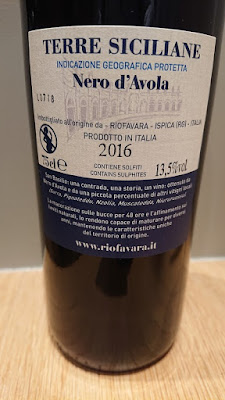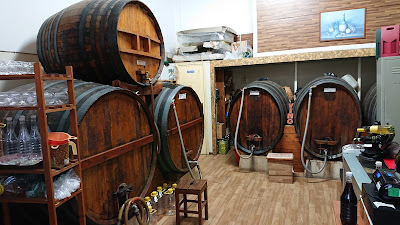Driving from Modica in South East Sicily, West towards Vittoria, you see polytunnels rather than vineyards.
Why do they need polytunnels when the climate is perfect for ripening grapes in the normal way?
We were later told that these vineyards covered in plastic were for the production of table grapes.
Sadly, it was our experience that some (a lot?) of Nero D'Avola was pretty poor stuff.
We visited a vino sfuso shop where people bought their vin ordinaire.
This was a delightful experience but the wines were very different from the bottled wines of the area.
The charming owner seemed a very traditional kind of person and one could imagine the wines were the same as they always had been. We asked him how he kept them fresh in the large barrels and he showed us a huge pill of sulphur which he said were the ancient method of stopping the wine going off. His clients didn't seem to mind as there was a steady stream of people picking up their table wine.
The house wine at our agriturismo was of that ilk.
Fast forward to the beautiful modern winery of Arianna Occhipinti just past the town (and airport) of Comiso.
The Ochipinti family are very much of the area with Arianna's uncle Giusto being one of the triumvirate founders of COS nearby. It was his influence that set Arianna on her course but she started with only 2 acres of vineyard and took out large loans.
Her intiative and courage paid off and she was able to increase her vineyard, buying land nearby where she had been sourcing grapes to add to her own production. Meanwhile she had farmed biodynamically from the beginning and her wines had taken off internationally.
The new winery is beautifully designed and executed.
 |
| Occhipinti vines next to the winery |
 |
| Draussen vor der Tur |
Albanello
Moscato di Alessandria
Frappato
Nero D'Avola
The big news here is of course Albanello. Described by D'Agata as 'largely unknown' and 'never cultivated extensively,' it is nevertheless highly thought of. It is native to this part of Sicily and Arianna Occhipinti planted Albanello around Chiaramonte Gulfi in 2005 and her SP68 white has 85% Albanello with 15% Moscato.
The SP68 is named after the road that passes by the vineyard. We bought the white version, freely available in all good wine shops as they say.
Nearby is the Baglio Occhipinti, a beautiful old farm with an antique winery still preserved within its walls.
Here was an old 'lagar' with gutters and space below for barrels
and a very comfortable reception rooms, kitchen, dining area, reception etc. The rooms are equally delicious.
An exceptionally attractive place to stay.
There are olive groves
and inevitably vines. The leading light of the Baglio appears to be Arianna Occhipinti's sister, the architect Fausta Occhipinti. Maybe she designed the new winery?
The other side of Modica, towards Noto is the Riofavara estate. This winery was not far from where we were staying and were encouraged by the mention of various native grape varieties which were included in some of their wines. It was founded in 1920 and is certified natural and biological.
 |
| Massimo Padova and daughter |
Niururuossu should be the Grosso Nero. Others indicate it as a variety similar to Barbera
Reganu is confirmed as a native Sicilian variety called Recunu very close to Grecanico but with some nearby French vines (chenin blanc).
Muscatedda = Moscatell
Nzolia = Inzolia
Surra = Frappato
Pignatieddu = Perricone
The first two are intriguing. Neither 'Wine Grapes' nor 'Native Wine Grapes of Italy' mentions Niururuosso, Nero Rosso, Rosso Nero, Grosso Nero or Nero Grosso but Galet has Niuru Grossu which he describes indeed as 'Cepage de cuve noir italien de Sicile.' So this grape may indeed be a rare 'autoctono.' Barbera by the way is most likely from Piemonte and although quite widely planted gets only as far as Sardegna as far as Italy is concerned.
Reganu or Recunu cannot be found anywhere at all but while checking Grecanico we discovered that this is nothing but Gagarnega! The grape of Soave in the Veneto, Gaganega seems to have travelled all over Italy so it is not impossible that it turns up in Sicily and has a local name.
Chardonnay
Moscato bianco (aka Moscato di Noto)
Muscat Blanc a petits grains
Cabernet Franc
Nero D'Avola
 |
| Riofavara chaix. |
 |
| shop |
 |
| Cellar with barrels. |
 |
| Tanks |
 | |||||||
| fermenting Cabernet Franc, we were told. |
 |
| Mound of stalks (right). |
 |
| Riofavara vines |
We bought
 |
| Inzolia, Grecanico (aka Garganega), Moscato |
 |
| Nero D'Avola, Surra, Pignateddu, Nzolia, Muscatedda and the rarissimo Niururuossu! |
Post Scriptum
We have to admit to a historical problem with Nero D'Avola so we look forward to tasting Riofavara's version.
And by strong recommendation of a fellow guest at our Agriturismo, this 14 percenter from the beautiful town of Scicli nearby.
While coming clean over Nero D'Avola we also have to ask for another misdemeanor to be taken into consideration. Cerasuolo di Vittoria. This blend of Frappato and Nero D'Avola had always seemed a bit like Santa Maddalena in Alto Adige whereby a grape we adore - Frappato and Schiava respectively - is beefed-up or more likely dumbed-down by the addition of Nero D'Avola and Lagrein respectively.
 |
| Ristorante Quore Matto, Scicli |
Nota Bene
Cerasuolo di Vittoria was the first and until now still the only DOCG of Sicilia. Gulfi's version is 70% Nero D'Avola but others may be 60% (Judeka) or 50% (Occhipinti).
The word Cerasuolo (cherry) refers to the taste in this case but in the other Italian Cerasuolo DOC - that of Abruzzo, Cerasuolo refers to the colour. Not a lot of people know that.
Also, Frappato ripens much later than Nero D'Avola so they have to be vinified separately and blended subsequently.
Envoi
Frabianco - Frappato vinificato in bianco. Might it catch on? Only time will tell.




























3 comments:
Robert, the Occhipinti website describes the SP68 white as 60% Moscato di Alessandria and 40% Albanello. But that may be the 2017. Did they tell you that the 2018 vintage is the Albanello-heavy blend?
Dear Bibulous, Sorry for the delay. It took a while to retrace my steps. In fact I got the 85/15 ratio from D'Agata (Native Wine Grapes of Italy, 2014). While as I say retracing my steps I came across various other ratios including 50/50 from one source and indeed more frequently your ratio of 60/40. So it seems this is an evolving process with your version the most up to date one. Mille grazie for raising this point and Fuerza a las castanetas!
Post a Comment